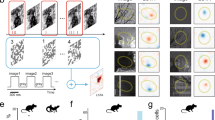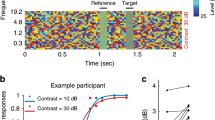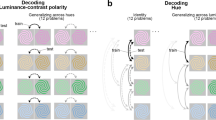Abstract
The early visual system is endowed with adaptive mechanisms that rapidly adjust gain and integration time based on the local luminance (mean intensity) and contrast (standard deviation of intensity relative to the mean). Here we show that these mechanisms are matched to the statistics of the environment. First, we measured the joint distribution of luminance and contrast in patches selected from natural images and found that luminance and contrast were statistically independent of each other. This independence did not hold for artificial images with matched spectral characteristics. Second, we characterized the effects of the adaptive mechanisms in lateral geniculate nucleus (LGN), the direct recipient of retinal outputs. We found that luminance gain control had the same effect at all contrasts and that contrast gain control had the same effect at all mean luminances. Thus, the adaptive mechanisms for luminance and contrast operate independently, reflecting the very independence encountered in natural images.
This is a preview of subscription content, access via your institution
Access options
Subscribe to this journal
Receive 12 print issues and online access
$209.00 per year
only $17.42 per issue
Buy this article
- Purchase on Springer Link
- Instant access to full article PDF
Prices may be subject to local taxes which are calculated during checkout







Similar content being viewed by others
References
Shapley, R.M. & Enroth-Cugell, C. Visual adaptation and retinal gain controls. in Progress in Retinal Research Vol. 3 (eds. Osborne, N. & Chader, G.) 263–346 (Pergamon, London, 1984).
Troy, J.B. & Enroth-Cugell, C. X and Y ganglion cells inform the cat's brain about contrast in the retinal image. Exp. Brain Res. 93, 383–390 (1993).
Rodieck, R.W. The First Steps in Seeing (Sinauer, Sunderland, Massachussets, 1998).
Shapley, R.M. & Victor, J.D. The effect of contrast on the transfer properties of cat retinal ganglion cells. J. Physiol. (Lond.) 285, 275–298 (1978).
Victor, J. The dynamics of the cat retinal X cell centre. J. Physiol. (Lond.) 386, 219–246 (1987).
Baccus, S.A. & Meister, M. Fast and slow contrast adaptation in retinal circuitry. Neuron 36, 909–919 (2002).
Demb, J.B. Multiple mechanisms for contrast adaptation in the retina. Neuron 36, 781–783 (2002).
Kaplan, E., Purpura, K. & Shapley, R. Contrast affects the transmission of visual information through the mammalian lateral geniculate nucleus. J. Physiol. (Lond.) 391, 267–288 (1987).
Sclar, G., Maunsell, J.H. & Lennie, P. Coding of image contrast in central visual pathways of the macaque monkey. Vision Res. 30, 1–10 (1990).
Bonin, V., Mante, V. & Carandini, M. The suppressive field of neurons in lateral geniculate. J. Neurosci. (in the press).
Laughlin, S. A simple coding procedure enhances a neuron's information capacity. Z. Naturforsch. [C] 36, 910–912 (1981).
Ruderman, D.L. The statistics of natural images. Network: Comput. Neural Syst. 5, 517–548 (1994).
Tadmor, Y. & Tolhurst, D.J. Calculating the contrasts that retinal ganglion cells and LGN neurones encounter in natural scenes. Vision Res. 40, 3145–3157 (2000).
Van Hateren, J.H. Spatiotemporal contrast sensitivity of early vision. Vision Res. 33, 257–267 (1993).
Schwartz, O. & Simoncelli, E.P. Natural signal statistics and sensory gain control. Nat. Neurosci. 4, 819–825 (2001).
Shapley, R. The importance of contrast for the activity of single neurons, the VEP and perception. Vision Res. 26, 45–61 (1986).
Shapley, R.M. & Man-Kit Lam, D. (eds.). Contrast Sensitivity (Bradford Books, 1993).
van Hateren, J.H. & van der Schaaf, A. Independent component filters of natural images compared with simple cells in primary visual cortex. Proc. Biol. Sci. 265, 359–366 (1998).
Najemnik, J. & Geisler, W.S. Optimal eye movement strategies in visual search. Nature 434, 387–391 (2005).
Oppenheim, A.V. & Lim, J.S. The importance of phase in signals. Proc. IEEE. 69, 529–541 (1981).
Field, D.J. Relations between the statistics of natural images and the response properties of cortical cells. J. Opt. Soc. Am. A 4, 2379–2394 (1987).
Saito, H. & Fukada, Y. Gain control mechanisms in X- and Y-type retinal ganglion cells of the cat. Vision Res. 26, 391–408 (1986).
Lankheet, M.J., Van Wezel, R.J., Prickaerts, J.H. & van de Grind, W.A. The dynamics of light adaptation in cat horizontal cell responses. Vision Res. 33, 1153–1171 (1993).
Yeh, T., Lee, B.B. & Kremers, J. The time course of adaptation in macaque retinal ganglion cells. Vision Res. 36, 913–931 (1996).
Lee, B.B., Dacey, D.M., Smith, V.C. & Pokorny, J. Dynamics of sensitivity regulation in primate outer retina: the horizontal cell network. J. Vis. 3, 513–526 (2003).
Zaghloul, K.A., Boahen, K. & Demb, J.B. Contrast adaptation in subthreshold and spiking responses of mammalian Y-type retinal ganglion cells. J. Neurosci. 25, 860–868 (2005).
Sherman, S.M. Tonic and burst firing: dual modes of thalamocortical relay. Trends Neurosci. 24, 122–126 (2001).
Tranchina, D., Gordon, J. & Shapley, R.M. Retinal light adaptation - evidence for a feedback mechanism. Nature 310, 314–316 (1984).
Smirnakis, S.M., Berry, M.J., Warland, D.K., Bialek, W. & Meister, M. Adaptation of retinal processing to image contrast and spatial scale. Nature 386, 69–73 (1997).
Chander, D. & Chichilnisky, E.J. Adaptation to temporal contrast in primate and salamander retina. J. Neurosci. 21, 9904–9916 (2001).
Brown, S.P. & Masland, R.H. Spatial scale and cellular substrate of contrast adaptation by retinal ganglion cells. Nat. Neurosci. 4, 44–51 (2001).
Solomon, S.G., Peirce, J.W., Dhruv, N.T. & Lennie, P. Profound contrast adaptation early in the visual pathway. Neuron 42, 155–162 (2004).
Reid, R.C., Victor, J.D. & Shapley, R.M. Broadband temporal stimuli decrease the integration time of neuron in cat striate cortex. Vis. Neurosci. 9, 39–45 (1992).
Lankheet, M.J., van Wezel, R.J. & van de Grind, W.A. Light adaptation and frequency transfer properties of cat horizontal cells. Vision Res. 31, 1129–1142 (1991).
Nolt, M.J., Kumbhani, R.D. & Palmer, L.A. Contrast-dependent spatial summation in the lateral geniculate nucleus and retina of the cat. J. Neurophysiol. 92, 1708–1717 (2004).
Derrington, A.M. & Lennie, P. The influence of temporal frequency and adaptation level on receptive field organization of retinal ganglion cells in cat. J. Physiol. (Lond.) 333, 343–366 (1982).
Troy, J.B., Bohnsack, D.L. & Diller, L.C. Spatial properties of the cat X-cell receptive field as a function of mean light level. Vis. Neurosci. 16, 1089–1104 (1999).
Lennie, P. Parallel visual pathways: a review. Vision Res. 20, 561–594 (1980).
Freeman, T.C., Durand, S., Kiper, D.C. & Carandini, M. Suppression without inhibition in visual cortex. Neuron 35, 759–771 (2002).
Hochstein, S. & Shapley, R.M. Quantitative analysis of retinal ganglion cell classifications. J. Physiol. (Lond.) 262, 237–264 (1976).
Sahani, M. & Linden, J.F. in Advances in Neural Information Processing Systems (eds. Becker, S., Thrun, S. & Obermayer, K.) 125–132 (MIT Press, Cambridge, Massachusetts, 2003).
Machens, C.K., Wehr, M.S. & Zador, A.M. Linearity of cortical receptive fields measured with natural sounds. J. Neurosci. 24, 1089–1100 (2004).
Acknowledgements
We thank D. Ringach for suggesting the singular value decomposition method and J. Victor for helpful comments. The study of natural images was performed in W.S.G.'s laboratory, supported by National Eye Institute grant R01EY11747. The study of physiological responses was performed in M.C.'s laboratory, supported by the James S. McDonnell Foundation 21st Century Research Award in Bridging Brain, Mind and Behavior.
Author information
Authors and Affiliations
Corresponding author
Ethics declarations
Competing interests
The authors declare no competing financial interests.
Supplementary information
Supplementary Fig. 1
Robustness of estimate of impulse response, and absence of slow contrast adaptation in cat LGN responses. (PDF 211 kb)
Supplementary Fig. 2
Measured responses and predictions of the descriptive model replotted as a function of linear frequency. (PDF 100 kb)
Supplementary Fig. 3
Independence of luminance and contrast gain control for two additional example cells. (PDF 102 kb)
Rights and permissions
About this article
Cite this article
Mante, V., Frazor, R., Bonin, V. et al. Independence of luminance and contrast in natural scenes and in the early visual system. Nat Neurosci 8, 1690–1697 (2005). https://doi.org/10.1038/nn1556
Received:
Accepted:
Published:
Issue Date:
DOI: https://doi.org/10.1038/nn1556
This article is cited by
-
Self-powered and broadband opto-sensor with bionic visual adaptation function based on multilayer γ-InSe flakes
Light: Science & Applications (2023)
-
Coding strategy for surface luminance switches in the primary visual cortex of the awake monkey
Nature Communications (2022)
-
Chronic bisphenol A exposure triggers visual perception dysfunction through impoverished neuronal coding ability in the primary visual cortex
Archives of Toxicology (2022)
-
An organic transistor with light intensity-dependent active photoadaptation
Nature Electronics (2021)
-
Population receptive fields of human primary visual cortex organised as DC-balanced bandpass filters
Scientific Reports (2021)



